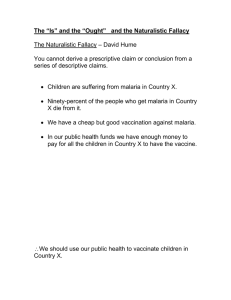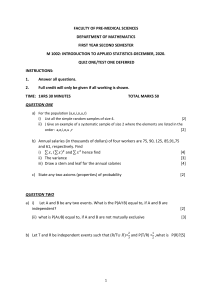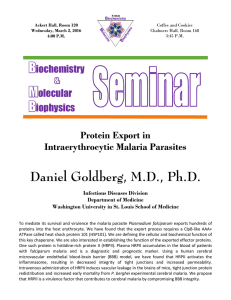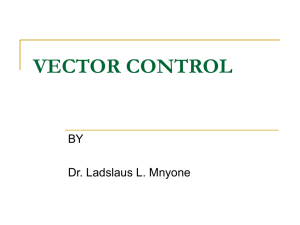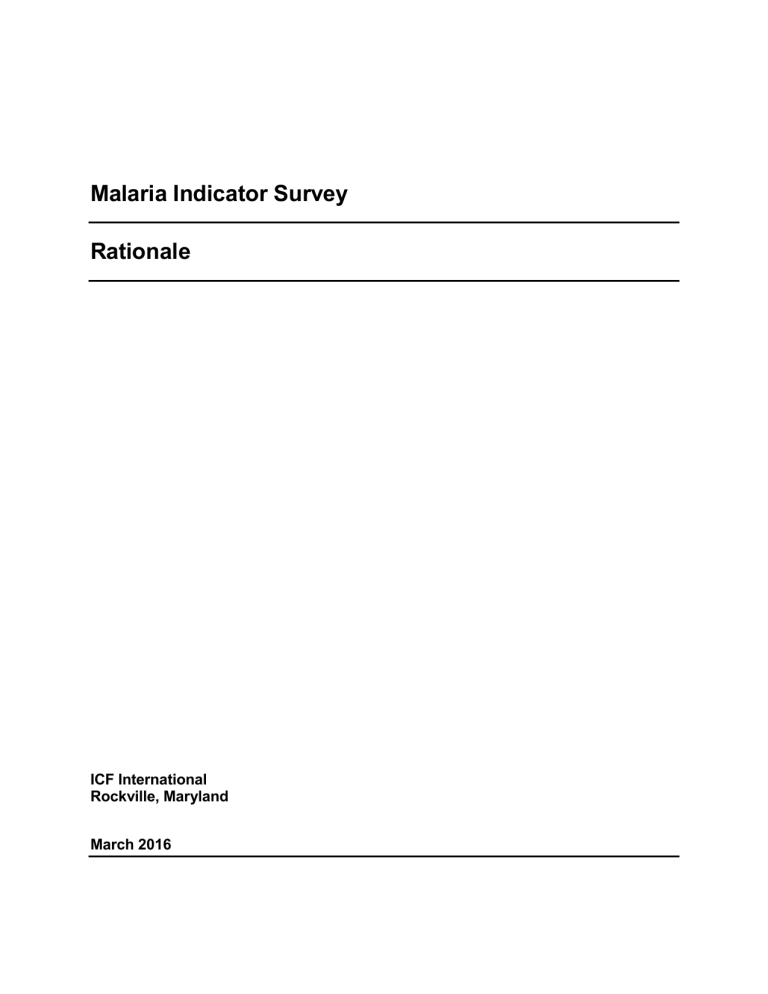
Malaria Indicator Survey Rationale ICF International Rockville, Maryland March 2016 RATIONALE PURPOSE The purpose of this rationale is to understand why each question from the set of questionnaires is important to the MIS. The rationale is divided into three sections corresponding to the Household Questionnaire, the Biomarker Questionnaire and the Woman’s Questionnaire. HOUSEHOLD QUESTIONNAIRE Introduction and Consent The Household Questionnaire begins with the interviewer’s introduction and a request for the respondent’s participation in the survey. Time of Interview (100) Time, recorded in questions 100 and 134, is used to determine the duration of the interview. Household Listing and Eligibility for the Household Questionnaire (1–9) All usual household members are listed, as well as all individuals who stayed with the household as guests the night preceding the interview (2). For all listed individuals, information is collected on their relationship to the head of the household, sex, residence status, and age (3–7). An important use of this information is to identify women who are eligible for the Woman’s Questionnaire. The data on the relationship of each household member to the head of the household provide a picture of the structure and composition of the household. The data on age and sex can be used to assess the degree to which the sample represents the population. Water and Toilet Facilities (101–107) These questions contribute to the calculation of the wealth index, which can be analyzed in relation to the malaria indicators. The major headings for source of drinking water (101), water for cooking and handwashing (102) and for type of toilet facilities (105) should be included in country-specific versions of the Household Questionnaire. Specific response categories under each major heading may be as detailed as necessary for each survey. Household Possessions (108–116) Questions about whether the household has electricity, a radio, a television, a telephone, a refrigerator, a bicycle, a motorcycle, and a car or a truck, to name some examples, are included primarily to provide components of the wealth index. Other questions about the type of fuel used for cooking, the number of rooms used for sleeping, ownership of agricultural land and livestock and possession of a bank account are also used for computing the wealth index. Such information is thought to be reported more reliably than a simple question on household income. Indoor Residual Spraying (IRS) (117–118) These questions should be retained in the questionnaire only for countries that implement IRS programs. The questions focus on spraying of the interior walls that took place in the 12 months preceding the survey. The question on who sprayed the house is included to determine whether the spraying was done as part of a government program or through a private entity. Ownership and Use of Mosquito Nets (119–130) Questions 121 to 129 are designed to capture information about the ownership, type and source of mosquito nets as well as the use of the mosquito nets by members of the population. Ascertainment of a full roster of nets in the household has been useful in determining if households have enough nets to protect all household members and if available nets are used by household members. The use of nets by 1 specific target groups of the population can also be examined, for example, children under age 5 and pregnant women who stayed in the household the night preceding the interview. Use of insecticide-treated nets (ITNs) decreases malaria-related morbidity and mortality, especially in vulnerable groups such as children under age 5 and pregnant women. ITNs provide protection both to the individuals sleeping under them by deterring mosquito bites and to other community members by killing mosquitoes, thereby reducing transmission of malaria parasites. For pregnant women, ITNs have been shown to be efficacious in reducing maternal anemia, placental infection, and low infant birth weight. For young children, ITN use is associated with a reduction of anemia, lower infant and child mortality, and fewer episodes of uncomplicated malaria. ITNs are simple, safe, and cost-effective. A net treated with insecticide is effective in repelling or killing mosquitoes before they have the chance to bite. Two types of ITNs can be obtained: long-lasting insecticidal nets (LLINs), and conventional ITNs. LLINs are ready-to-use nets that are pretreated at a factory and require no further treatment for 3–5 years. LLINs are now used exclusively in net distribution campaigns. A conventional ITN is a net that has been soaked with insecticide within the last 12 months. There is a growing recognition that surveys of the coverage of health interventions should describe how equitably interventions are implemented among different economic groups. Answers to questions 122 to 129, when paired with the wealth index, can indicate whether ownership of ITNs is associated with poverty. The following limitations should be noted. First, because of issues of recall, this survey may not provide reliable estimates of net retreatment status. Second, it may be difficult to interpret the findings at the national level, as malaria transmission is most often localized; if the survey is limited to malaria-endemic areas, however, the interpretation will be clearer. Third, mosquito net indicators may be biased by the seasonality of survey data collection, which is most often done during the peak transmission season, when reported net ownership and use may be higher than during non-peak transmission periods. In addition, the questionnaire does not ask whether the insecticide used to treat the net is an approved insecticide. There are also no questions about whether the net was washed after treatment or about the physical condition of the net (holes, tears, etc.), which can reduce its effectiveness. Dwelling Characteristics (131-134) The main materials that constitute the floor and roof are additional components of the wealth index. These characteristics are observed by interviewers and not reported by interviewees. 2 BIOMARKER QUESTIONNAIRE Anemia and Malaria Testing (101–130) Anemia is a common manifestation of malaria. A significant proportion of anemia in children under age 5 in malaria-endemic areas is due to malaria. Severe anemia is a major cause of morbidity and mortality in malaria-endemic areas. Malaria-related anemia is associated with worsening of preexisting anemia and with infant deaths. In malaria, the development, the rate of progression, and the degree of anemia depend on the severity and duration of the presence of the malaria parasite in the blood. Malaria causes anemia when the malaria parasite enters into the red blood cell and the malaria-infected red blood cell is then broken down (hemolyzed). Malaria infection can also cause red blood cell production to slow down. Anemia results if the breakdown of red blood cells is faster than the production of new cells. Demonstrated reductions in severe anemia among children under age 5 in malaria intervention trials support the use of anemia in young children as an indicator of malaria burden and the impact of malaria interventions in stable transmission settings. Therefore, Roll Back Malaria (RBM) Monitoring and Evaluation Reference Group (MERG) has recommended that anemia testing of children under age 5 be included in all Malaria Indicator Surveys conducted in areas of stable malaria transmission. The current recommended procedure is to measure hemoglobin levels using the HemoCue® instrument on blood collected from a finger prick in children ages 6–59 months. The recommended procedures for conducting anemia testing are described in the separate Demographic and Health Surveys biomarker field manual (ICF International. 2015. DHS Biomarker Field Manual. Rockville, Maryland, U.S.A.: ICF International). Malaria parasite prevalence is a useful indicator of malaria burden. Our understanding of the epidemiology of malaria can be improved and the progress of control efforts can be tracked more effectively if estimates of parasite prevalence are available in conjunction with intervention coverage data. However, parasite prevalence is not a reliable measure of short-term impact of prevention efforts, as the prevalence rates may merely reflect differences in the timing of survey in relation to annual variation in prevalence (seasonal fluctuations, abnormal rainfall or temperature, etc). Parasite prevalence is better suited to measuring changes in malaria burden over a longer term during which changes in parasite prevalence are expected to be much greater and outweigh within-year variation. To demonstrate a reliable trend, no more than four data points within a ten-year span are generally needed. Malaria testing may include the use of a malaria rapid diagnostic test—for which results are available to the field team—and microscopy of patient blood smears, the results of which are available after fieldwork is complete. The RBM MERG has recommended that malaria parasitemia testing of children ages 6–59 months be included in the Malaria Indicator Surveys in areas of stable malaria transmission, which is ideally conducted during the high-transmission season for malaria. RBM recommendations specify that parasite prevalence be based on the results of a high quality RDT in settings where P. falciparum accounts for nearly all infections (≥90%) and where low level infections (<200 parasites/μl) are uncommon. Otherwise, parasite prevalence should be estimated based on microscopically examined blood films prepared in the field and read in a quality-controlled laboratory conducted by well-trained microscopists. 3 Additional information regarding the recommendations and guidelines for parasitemia testing are included in the Household Survey Indicators for Malaria Control report1. Questions 107–110 are designed to obtain permission for a medical referral to assess and possibly treat anemia and malaria infection, if the results of anemia and malaria testing indicate the presence of severe anemia and/or malaria. Following these questions, there is a page with country-specific information for parents and guardians regarding the dosage of medication for those children receiving treatment for malaria. Questions 118-129 are asked to identify children who may have symptoms of severe malaria, or those who have recently received antimalarial medication and thus are not eligible to receive treatment from survey teams for a positive test. This section of the questionnaire contains referrals for children identified as having either severe anemia or symptoms of severe malaria. 1 http://www.malariasurveys.org/documents/Household%20Survey%20Indicators%20for%20Malaria%20Control.pdf 4 WOMAN’S QUESTIONNAIRE SECTION 1. RESPONDENT’S BACKGROUND Introduction and Consent The Woman’s Questionnaire begins with the interviewer’s introduction and an informed consent statement requesting the respondent’s participation in the survey. Time of Interview (101) Time, recorded in questions 101 and 429, is used to determine the duration of the interview. Date of Birth and Age of Woman (102–103) Both the month and year of birth as well as the woman’s age at last birthday are asked. The interviewer is instructed to reconcile the birth date and age, if possible. Reconciliation in the field is preferable to leaving inconsistencies that will likely plague the editing process and must eventually be resolved by the analyst. Education and Literacy (104–108) Education is one of the main factors influencing morbidity, mortality, health care-seeking behavior, and health-related preventive behavior. Literacy is presumed for all women who reported attending a level of school higher than secondary. Women will less schooling are asked to read a sentence. Religion and Ethnicity (109–110) These questions are relevant in countries with religious and/or ethnic diversity. There is considerable evidence that health-related behavior is influenced by normative attitudes associated with religious values and ethnic identity. This information has potential programmatic value in identifying groups with special needs. Malaria Messages (111–112) Many malaria control programs now include educational elements focusing on the adoption of preventive behaviors. The questions in this section establish whether women have been exposed to any media messages about malaria and, if so, the source of these messages. 5 SECTION 2. REPRODUCTION Lifetime Fertility (201–211) Questions 201–211, on lifetime fertility, are standard preliminary questions aimed at determining the total number of births the woman has had, and they set the stage for the detailed birth history in questions 212–221. Experience has indicated that certain types of events are underreported in women’s reproductive histories; this is the reason for distinguishing between children living at home, those living away, and those who have died. Children who die in early infancy are particularly likely to be underreported, thus a specific probe is included to help capture those events. The collection of the lifetime fertility data by child’s sex also improves reporting. Question 211 is used to determine whether any of the births took place in the six years preceding the survey. The data collected will be used to calculate denominators for the estimation of malaria program activity and malaria morbidity indicators. Recent Birth History (212–224) A detailed birth history is obtained for the six years preceding the survey and provides the data that will form the basis of Sections 3 and 4. The interviewer is required to probe and convert all dates of births to calendar form (216). These probes may be time-consuming, but they are critical to obtaining high-quality data. The recent birth history includes the line number of children from the Household Questionnaire (220). This facilitates linking the data in the Household Questionnaire to particular births. Question 223 ensures that the history information has been collected correctly. Pregnancy Status (225–226) The information on current pregnancy status will be used to calculate pregnant women’s use of bed nets. 6 SECTION 3. PREGNANCY AND INTERMITTENT PREVENTIVE TREATMENT (IPT) OF MALARIA Antenatal Care and Preventive Treatment (301–307) The questions in this section refer to the pregnancy for the most recent birth (whether living or not at the time of the interview) within the six years preceding the survey. Malaria infections can cause several pregnancy-related complications. The clinical picture of malaria infection during pregnancy may range from asymptomatic to severe, life-threatening illness, depending on a number of factors including: the mother’s natural immunity to malaria, the number of pregnancies she has had, HIV status, the climate, and the level of malaria transmission in the area (endemic or epidemic). Maternal death may result either directly from severe malaria or indirectly from malaria-related complications including severe anemia. In addition, malaria may result in a range of adverse pregnancy outcomes, including spontaneous abortion, low birth weight, and neonatal death. Interventions to reduce the risks of related malaria in pregnancy complications include the use of ITNs and intermittent preventive treatment with sulfadoxinepyrimethamine (IPTp-SP) in areas of medium to high malaria transmission. IPTp-SP can be used to prevent infection or treat a presumed infection in pregnant women. The World Health Organization (WHO) recommends that all pregnant women living in areas of medium to high malaria transmission receive IPTp-SP as early as possible in the 2nd trimester and every scheduled ANC visit thereafter, at least one month apart. HIV positive women on cotrimoxazole should not receive IPTpSP.2 A recent meta-analysis showed that pregnant women in sub-Saharan Africa who took three or more doses of SP/Fansidar during pregnancy had higher birth weights and lower risk of low birth weight babies than those who received two doses.3 Information on whether SP/Fansidar was given during an antenatal visit, by a community health worker or from another source is collected to determine whether WHO recommendations are being followed. The following limitations should be noted. Retrospective questions about IPT given during a previous pregnancy may be subject to recall bias. It is difficult to determine at what stage during pregnancy IPT was given. IPT use may be misleading at the national level, as malaria transmission is most often localized and local malaria transmission may affect adherence to national IPT guidelines. 2 http://www.who.int/malaria/iptp_sp_updated_policy_recommendation_en_102012.pdf Kayentao K, Garner P, Maria van Eijk A, et al. Intermittent Preventive Therapy for Malaria During Pregnancy Using 2 vs 3 or More Doses of Sulfadoxine-Pyrimethamine and Risk of Low Birth Weight in Africa: Systematic Review and Meta-analysis. JAMA.2013;309(6):594-604. 3 7 SECTION 4. HEALTH AND PROMPT AND EFFECTIVE TREATMENT FOR CHILDREN WITH FEVER Fever and Treatment (401–428) The questions in this section refer to all of the woman’s living children born since January of the fifth calendar year before the survey fieldwork. The clinical presentation of malaria is variable, but the single most common symptom is fever. Fever in children is also a common symptom of other infections and is, therefore, not specific to malaria. The concern about high fever may prompt caretakers to seek treatment for a perceived life-threatening illness in young children. WHO recommends that all patients with suspected malaria seek treatment promptly and undergo a diagnostic test for malaria before treatment with recommended first-line antimalarial drugs is initiated. Presumptive treatment based on clinical suspicion of malaria should be considered only when diagnostic testing is not available. The promptness with which diagnosis and treatment for malaria is possible depends on care seeking behaviors for children with fever. Questions are asked about the time between onset of fever and care seeking. Diagnostic capacity is only recently being scaled up and is currently limited in many malaria-endemic areas. Questions on whether patients with fever had blood samples taken for testing help to understand the country’s current malaria diagnostic capacity. Where diagnostic services are available, treatment should only be given to those with confirmed malaria infection. Limiting treatment to infected individuals helps prevent the development of antimalarial-resistant parasites and prevents unnecessary waste of resources. In addition, those who test negative for malaria infection should be more likely to have other causes of fever (such as acute respiratory infections) investigated and properly treated. WHO recommends that treatment of malaria be prompt and utilize effective first-line or second-line antimalarial medicines according to national policy. Questions on the time between onset of fever and care seeking, on the type of drug taken and the timing of first dose in relation to symptom onset provide information on whether this recommendation is followed. With prompt and effective treatment of the illness, it is hoped that progression to severe malaria and death will be prevented. There are many barriers to receiving prompt and effective treatment, including lack of knowledge, low education, and poverty. Some of these issues can be explored using information from other parts of the survey. The following limitations should be noted while considering responses to questions 401–428 and their use in estimating national-level indicators of case management in children under age 5. First, because of imperfect respondent recall, estimates of fever episodes within the previous 2 weeks, receipt of a finger or heel blood test, the length of time after the onset of fever before an antimalarial drug was given, or the identification of the specific drug given may be biased. Second, reported fevers may not have been due to malaria infection. Third, there is no way of knowing whether antimalarial treatments were administered correctly. Fourth, the questionnaire only asks about the woman’s biological children and, therefore, may miss fostered or other children whose mothers are not in the household. Last, it may be difficult to make comparisons between countries that have different antimalarial drug policies or to look at trends over time, as treatment recommendations have changed dramatically over the last decade. 8
